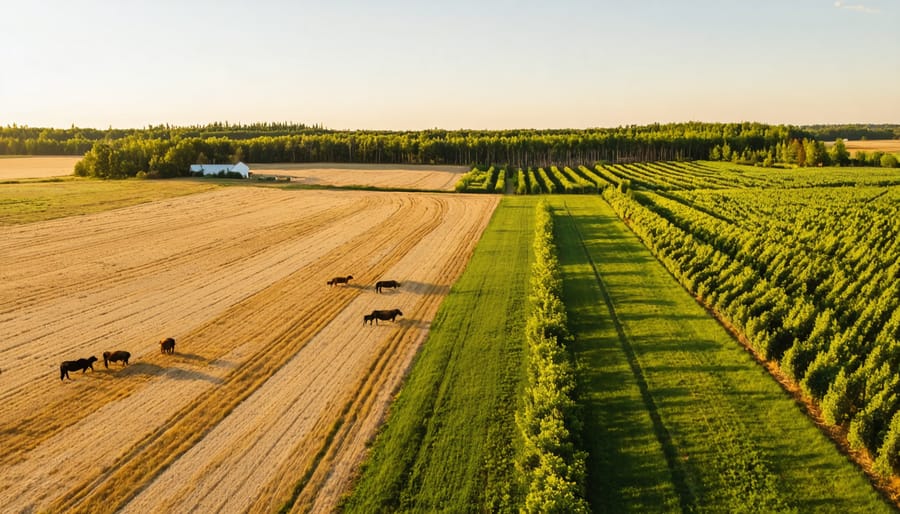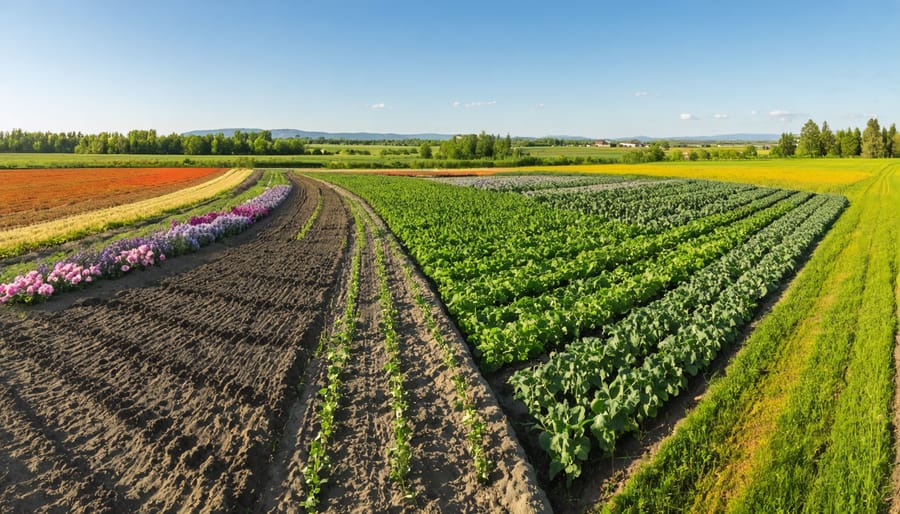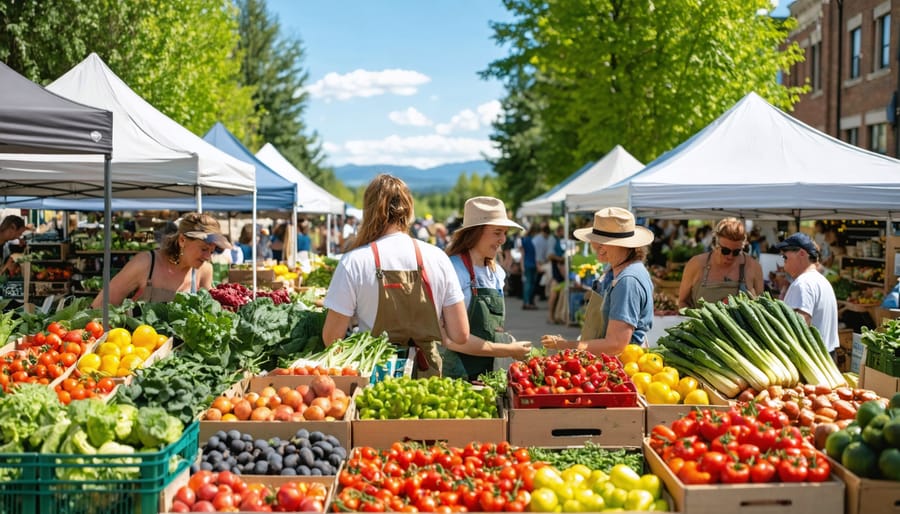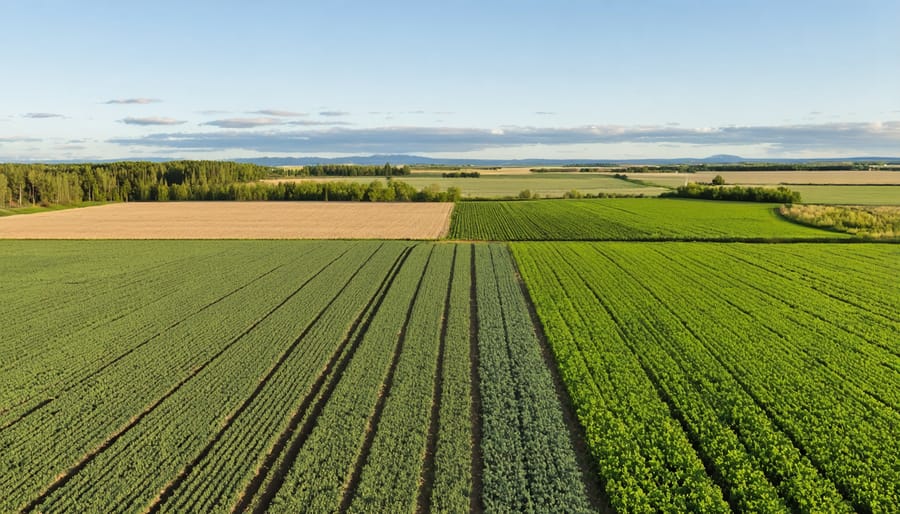Transform depleted farmland into thriving, profitable ecosystems through regenerative agriculture – a proven system that’s revolutionizing Canadian farming while building lasting wealth for future generations. Across Alberta’s prairies, farmers are discovering that regenerative practices don’t just restore soil health; they create robust, drought-resistant operations that significantly reduce input costs while increasing yields.
By mimicking nature’s time-tested patterns, regenerative agriculture rebuilds organic matter, enhances biodiversity, and improves water retention – all while sequestering carbon and creating new revenue streams through carbon credits and premium market access. From reduced fertilizer dependency to improved livestock integration, these methods are delivering 15-30% higher profits for early adopters while regenerating the land that sustains us.
This shift represents more than environmental stewardship; it’s a practical business solution backed by growing market demand and documented success stories from across the Canadian agricultural landscape. As climate pressures mount and input costs rise, regenerative agriculture offers a clear path forward that aligns profitability with ecological restoration, ensuring both farm viability and environmental resilience for generations to come.
The Financial Case for Regenerative Practices
Reduced Input Costs
One of the most compelling financial advantages of regenerative agriculture is the significant reduction in input costs. Alberta farmers implementing these practices typically report 30-50% savings on fertilizer expenses within the first three years. This is achieved through enhanced soil biology and improved nutrient cycling, which naturally increases nitrogen fixation and mineral availability.
Pesticide costs also drop substantially as healthier soils support more resilient crops. Local farmers have documented up to 60% reduction in pesticide use, as diverse crop rotations and beneficial insect populations naturally manage pest problems. For example, the Johnson family farm near Red Deer decreased their annual pesticide budget from $45,000 to $18,000 within four years of transitioning to regenerative practices.
Water costs see similar improvements. Enhanced soil organic matter acts like a sponge, increasing water retention capacity. For every 1% increase in organic matter, soil can hold an additional 25,000 litres of water per hectare. This translates to reduced irrigation needs and better drought resilience. Several irrigation-dependent farms in Southern Alberta report 40% lower water usage after implementing regenerative practices.
These savings compound over time. The initial investment in transition is typically recovered within 2-3 growing seasons through reduced input costs alone, not counting additional revenue streams from improved yield quality and soil carbon programs.
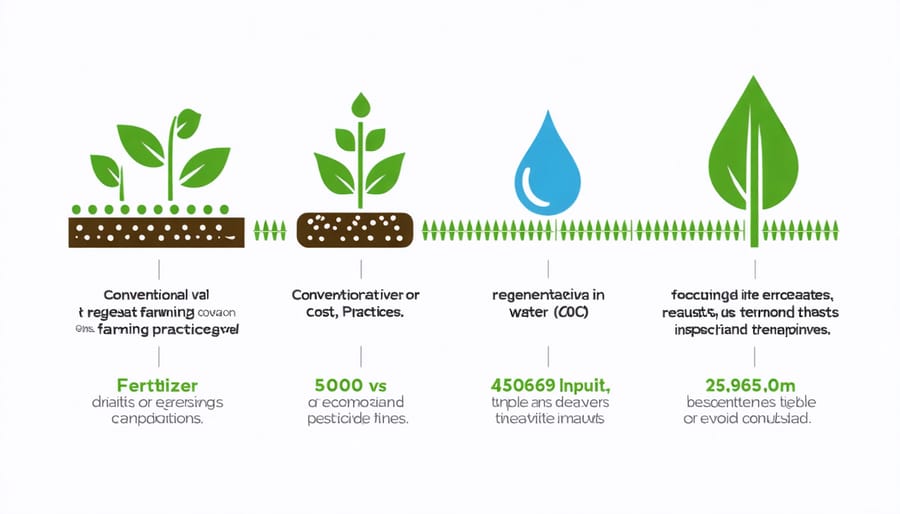
Premium Market Access
Farmers practicing regenerative agriculture are increasingly finding access to premium markets that value sustainable production methods. Many consumers are willing to pay more for products grown using environmentally conscious practices, creating opportunities for higher returns. Through regenerative agriculture certification, producers can verify their practices and access these premium markets more effectively.
In Alberta, several success stories demonstrate this potential. The Organic Box, a local food distribution company, offers premium prices to farmers who follow regenerative practices. Similarly, craft breweries across the province are partnering with regenerative grain farmers, paying up to 25% more for sustainably grown barley and wheat.
Direct-to-consumer marketing has proven particularly successful, with regenerative farmers reporting 30-40% higher margins compared to conventional distribution channels. Community Supported Agriculture (CSA) programs and farmers’ markets provide excellent venues for connecting with conscious consumers who appreciate the added value of regeneratively produced food.
Major retailers are also joining the movement. Sobeys and Loblaws have introduced special product lines featuring items from certified regenerative farms, offering long-term contracts at premium prices. These partnerships provide stable income streams while encouraging the adoption of sustainable farming practices.
For livestock producers, grass-fed and pasture-raised certification programs have opened doors to specialty butcher shops and restaurants willing to pay premium prices for sustainably raised meat products.
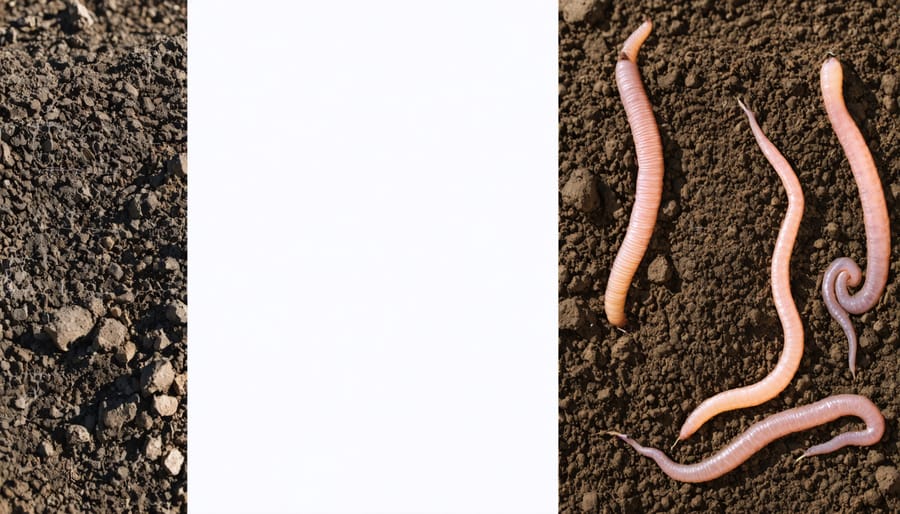
Soil Health: Your Farm’s Greatest Asset
Carbon Storage and Soil Structure
One of the most remarkable benefits of regenerative agriculture lies in its capacity for improving soil fertility through enhanced carbon storage and soil structure. When farmers implement practices like minimal tillage and cover cropping, they create optimal conditions for soil microorganisms to thrive, leading to increased organic matter retention.
In Alberta’s agricultural landscape, properly managed soils can sequester between 0.1 to 1 tonne of carbon per hectare annually. This carbon storage occurs as soil organisms break down organic matter, creating stable compounds that improve soil structure and water retention capacity. The process forms aggregates – small clusters of soil particles held together by organic materials and microbial substances – which create essential pore spaces for air and water movement.
These improved soil conditions result in better water infiltration and storage, reducing runoff during heavy rains and maintaining moisture during dry periods. For example, research at the University of Alberta has shown that fields managed under regenerative practices can hold up to 25% more water compared to conventionally tilled fields.
The enhanced soil structure also provides better root penetration and nutrient availability for crops. As organic matter levels increase, the soil’s cation exchange capacity improves, allowing it to hold and release nutrients more effectively. This natural process reduces the need for synthetic fertilizers while building long-term soil resilience, making farms more adaptable to climate variations while contributing to carbon sequestration efforts.
Water Retention Benefits
In Alberta’s often unpredictable climate, water management is crucial for farm success. Regenerative agriculture practices significantly improve soil’s water retention capacity, creating a natural buffer against both drought and flooding conditions. Farmers implementing these methods report using up to 40% less irrigation water compared to conventional farming practices.
The enhanced water retention comes from increased organic matter in the soil and improved soil structure. When soil health improves, it creates a sponge-like effect, allowing the ground to hold more moisture during dry spells and drain more effectively during heavy rainfall. This natural water management system has helped many Alberta farmers reduce their irrigation costs while maintaining crop yields, even during challenging growing seasons.
Local farmer Sarah Thompson from Lethbridge County shares her experience: “Since adopting regenerative practices five years ago, we’ve cut our irrigation needs by nearly half. The soil just holds moisture better, and our crops are more resilient during dry spells.”
The benefits extend beyond individual farms. Improved water retention helps maintain groundwater levels and reduces runoff, contributing to watershed health throughout the region. This is particularly valuable in areas where water access is limited or costly.
For those considering the switch, simple practices like maintaining year-round soil cover and minimizing tillage can start improving water retention within the first growing season. Many farmers report seeing noticeable differences in soil moisture levels within two to three years of implementing these practices.
Alberta Success Stories
Prairie Crop Rotation Innovation
Third-generation farmer Sarah Henderson from Red Deer County transformed her 800-hectare operation through innovative crop rotation practices, demonstrating the remarkable potential of regenerative agriculture in Prairie conditions. Her success story showcases how thoughtful crop sequencing can enhance soil health while maintaining profitable yields.
Henderson’s rotation strategy includes a diverse mix of cash crops and cover crops spread across five years. The sequence begins with canola, followed by spring wheat undersown with red clover, then yellow peas, oats paired with hairy vetch, and finally barley. This carefully planned rotation has increased her soil organic matter by 2.3% over six years while reducing fertilizer costs by 35%.
“The key was understanding how each crop contributes to soil health,” Henderson explains. “The legumes fix nitrogen, the deep-rooted crops break up compaction, and the cover crops protect the soil year-round.” Her approach has proven particularly effective during drought years, with crops showing better resilience compared to neighboring conventional farms.
The financial results speak volumes: Henderson’s input costs have decreased by $85 per hectare annually, while her yield stability has improved by 28% compared to her previous conventional system. Local soil tests have shown significant improvements in water retention capacity and beneficial microorganism activity.
This Prairie success story demonstrates how well-planned crop rotations can create a win-win situation for both the environment and farm economics.
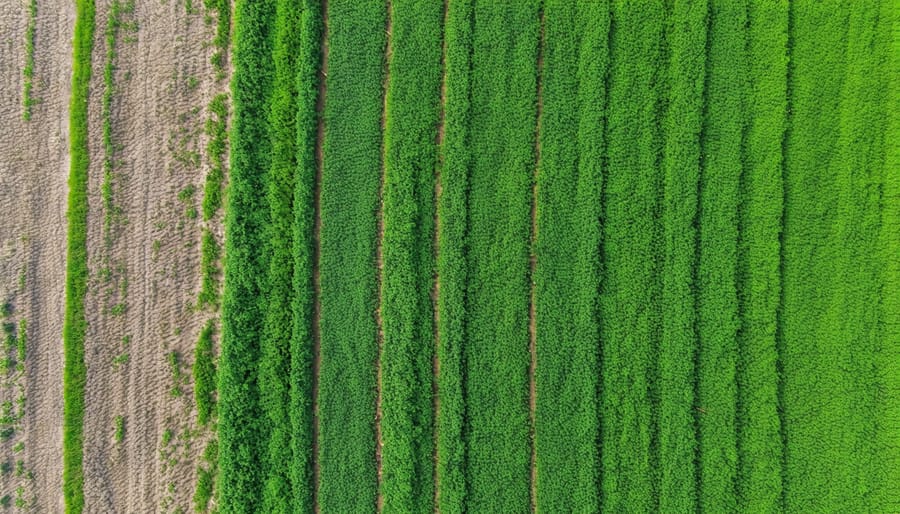
Grazing Management Transformation
When Doug and Sarah MacKenzie of Redwood Meadows Ranch in central Alberta decided to transform their conventional cattle operation, they weren’t sure what to expect. By implementing rotational grazing techniques and integrating their livestock into a regenerative system, they’ve witnessed remarkable changes in just three years.
Their 800-hectare ranch now operates on a carefully planned grazing schedule, where cattle are moved every 1-2 days between paddocks. This approach has increased grass recovery periods from 30 to 90 days, resulting in deeper root systems and improved soil structure. The MacKenzies have documented a 40% increase in available forage and reduced their winter feed costs by nearly $45,000 annually.
What’s particularly noteworthy is the dramatic improvement in soil water retention. During the 2021 drought, while neighboring farms struggled, their pastures remained relatively resilient. Their soil organic matter has increased from 2.3% to 3.8%, significantly improving carbon sequestration and water-holding capacity.
The transformation hasn’t just benefited the land – their cattle health has improved markedly. Veterinary costs have decreased by 30%, and weaning weights have increased by an average of 25 kilograms per calf. The MacKenzies now host regular field days, sharing their experiences with other Alberta ranchers interested in making similar transitions.
Getting Started with Regenerative Practices
First-Year Focus Areas
When transitioning to regenerative agriculture, focusing on key practices in your first year helps build a strong foundation. Start with soil testing to understand your baseline and track improvements. Many Alberta farmers find success by implementing no-till practices gradually, beginning with 20-30% of their land to manage the learning curve.
Introducing cover crop selection is another crucial first step, with cereals and legumes being particularly successful in our climate. Consider starting with hardy options like fall rye or field peas, which provide soil protection during harsh Prairie winters.
Rotational grazing represents another accessible entry point, even on a small scale. Start by dividing one or two fields into paddocks and moving livestock every 3-5 days, adjusting based on your observations and grass recovery rates.
Managing residue effectively is essential – aim to maintain at least 30% ground cover after harvest. This approach helps retain moisture, particularly valuable during Alberta’s dry spells, while feeding soil organisms.
Minimize chemical inputs gradually rather than eliminating them immediately. Focus on reducing applications by 25% in the first year while monitoring crop health and pest populations. This measured approach helps maintain yield stability while building soil health and natural resistance to pests and diseases.
Remember, success in year one isn’t about implementing everything at once, but rather mastering a few fundamental practices that suit your specific operation and climate conditions.
Available Support and Resources
Alberta farmers interested in transitioning to regenerative agriculture have access to numerous support systems and funding opportunities. The Canadian Agricultural Partnership (CAP) offers grants of up to $75,000 for implementing sustainable farming practices, including soil health improvements and water management systems.
The Alberta Soil Health Initiative provides free soil testing and consultation services, helping farmers establish baseline measurements and track improvements. Local agricultural societies across the province offer mentorship programs, connecting experienced regenerative farmers with those starting their journey.
Organizations like Young Agrarians Alberta facilitate land-matching services and apprenticeship opportunities, particularly valuable for new farmers embracing regenerative methods. The Environmental Farm Plan program supports farmers with technical assistance and potential funding for implementing sustainable practices.
Several financial institutions, including Farm Credit Canada and ATB Financial, offer specialized loans and financing options for regenerative agriculture projects. These programs often feature flexible repayment terms that align with seasonal cash flows.
For ongoing learning and community support, the Regenerative Agriculture Alliance of Alberta hosts monthly workshops, field days, and online forums. Their resource library includes region-specific guides, case studies, and planning tools. The Alberta Farm Sustainability Extension Working Group provides free on-farm consultations and helps farmers develop customized transition plans.
Don’t hesitate to reach out to your local agricultural fieldman or conservation district office for additional resources and community connections.
The adoption of regenerative agriculture practices presents a compelling opportunity for Canadian farmers to create a more resilient and profitable future while actively contributing to environmental stewardship. By implementing these methods, Alberta’s agricultural community has demonstrated that it’s possible to increase soil health, boost crop yields, and reduce input costs while building climate-resilient operations.
The evidence is clear: regenerative practices can lead to improved water retention, reduced erosion, and enhanced biodiversity, all while maintaining or increasing farm profitability. Success stories from across the province show that transitioning to these methods not only helps secure long-term farm viability but also opens doors to premium markets and carbon credit opportunities.
As we face increasing environmental challenges and market pressures, the time to act is now. Whether you’re considering a full farm transition or starting with a single field trial, every step toward regenerative practices contributes to a stronger agricultural future. By working together, sharing knowledge, and supporting one another, Alberta’s farming community can lead the way in building a more sustainable and prosperous agricultural sector for generations to come.
Remember, the journey to regenerative agriculture is a community effort, and resources and support are available through local agricultural extension services and farmer networks. Your next step could be the beginning of a transformative journey for your farm and our environment.


